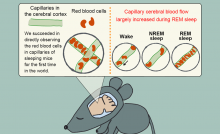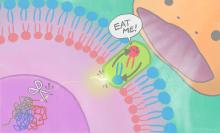Biology Neuroscience
News
15 Sep 2021
Using the lamprey, researchers from Japan analyzed the photosensory mechanism of the pineal organ, also called the pineal gland, in non-mammalian vertebrates and discovered a novel mechanism of pineal color discrimination (two-cell system) in which two types of photoreceptor cells, each containing two different opsins, are used to detect color. This discovery may provide insight into the evolution of color detection in other animals, including color vision in humans.
09 Sep 2021
Researchers from the University of Tsukuba and Kyoto University find that capillary blood flow in the brain, which is important for delivering oxygen and nutrients and removing waste products, is increased in mice during the dream-active phase of sleep.
07 Sep 2021
Recreating major pathological features of Parkinson’s disease in a lab-grown, human mini-brain will help researchers to explore new treatments. This is the first time that Lewy bodies, a hallmark of Parkinson’s disease in patients’ brains, have been produced in the laboratory, offering new insights into the disease.
06 Sep 2021
Neuroscientists develop a new approach to better understand the neural mechanism underlying deductive and inductive reasoning
12 Aug 2021
Experiments conducted on genetically modified mice clarify the role of a protein in regulating properties of specific hippocampal neural circuits
21 May 2021
Chuo University and Hokkaido University researchers have found that infants take less than a second to completely process visual information and have the same temporal limitation in processing visual information as seen in adults.
26 Mar 2021
An ‘eat-me’ signal displayed on cell surfaces requires activation of a lipid-scrambling protein by a nuclear protein fragment.
19 Mar 2021
Through a series of prosocial choice tasks, researchers reveal prosocial and antisocial characteristics in male convict cichlid fish. The fish distinguish between female breeding partners, unknown females, and rival males by adjusting their actions to either provide food for both them and the females or avoid providing food for the rival males.
10 Mar 2021
Researchers reveal the path of information received by the hippocampus. Using optogenetics during large-scale recordings of rat subiculum, they discovered that the subiculum distributes information from the hippocampus to 4 downstream regions of the brain. They observed that the theta and sharp-wave/ripples in the subiculum controlled information transmission with millisecond precision according to the target region. This provides the foundation for a comprehensive understanding of the hippocampal memory system.
28 Feb 2021
Spinocerebellar ataxia type 3 (SCA3), also known as Machado-Joseph Disease (MJD), describes the most common form of dominantly inherited ataxia in many populations worldwide, including Hong Kong and mainland China. SCA3 or MJD patients often present problems with gait and balance, blurred vision, and speech difficulties. The symptoms are progressive, and patients may eventually decline into a bed-ridden state. To date, SCA3 or MJD remains an incurable disorder.
Collaborating with the University of Oxford, Professor Ho Yin Edwin Chan’s research team from the School of Life Sciences of The Chinese University of Hong Kong (CUHK) recently unveiled the counteracting relationship between pre-mRNA-processing factor 19 (Prpf19) and exocyst complex component 7 (Exoc7) in controlling the degradation of disease protein and neurodegeneration of the rare hereditary ataxia. The research findings have been published in the prestigious scientific journal, Cell Death & Disease.
25 Feb 2021
New study shows that uneven accumulation of amyloid β is linked to olfactory dysfunction or partial loss of smell, an early symptom of Alzheimer’s disease
14 Jan 2021
Researchers from the University of Tsukuba have discovered a group of neurons in the mouse brainstem that control muscle tone. Inhibiting these neuronal cells caused mice to move during REM sleep, reminiscent of REM sleep behavior disorders. These neurons were also responsible for episodes of cataplexy in a mouse model of narcolepsy; inhibiting them reduced the number of cataplexic bouts. These circuits could thus be a new target for treating these sleep disorders.
20 Nov 2020
A new mechanism of action by which misfolded proteins cause indirect damage to neurons
02 Nov 2020
DGIST scientists are learning more about the molecular processes involved in the formation of well-communicating nerve fibres.
14 Sep 2020
Scientists at Daegu Gyeongbuk Institute of Science and Technology, Korea, show that it is possible to distinguish between left-handed and right-handed people by noninvasively monitoring just their brain activity during passive tactile stimulation. These results are key in haptic research (the study of sensory systems) and have various important implications for brain–computer interfaces, augmented reality, and even artificial intelligence.
09 Sep 2020
Running is a fundamental mode of human movement that most of us perform effortlessly without conscious thought. Some may run regularly for exercise, or even undergo serious, professional training for completing marathons. This apparent ease of running belies the enormous biomechanical complexity of running, the coordinated control of which is accomplished by an intricate neuronal network in the brain and spinal cord.
12 Jun 2020
Researchers at the University of Tsukuba and RIKEN in Japan spark a hibernation-like state in mice—a species that does not naturally hibernate
04 Jun 2020
Researchers from University of Tsukuba and the University of Tokyo identify neurons responsible for memory consolidation during REM sleep
18 Feb 2020
- Participants of 'International SYNAPSE Project', DGIST & POSTECH sign an MOU to build a joint cooperation system
20 Jan 2020
A resource for journalists to find stories and sources. Focus On: Brain highlights research and experts exploring questions ranging from basic structure and function, to technology, diseases and treatments.
10 Jan 2020
An implantable device has the potential to revolutionize how neuroscientists study the brain and treat diseases.
08 Jan 2020
New findings could lead the way towards treatments for intellectual disability in Down syndrome.
20 Dec 2019
Over 70% of rare disease patients and non-patients are aware of the patient registry but the participation rate accounted for less than 30%, according to a recent survey of the public’s acknowledgement of and participation in the rare disease patient registry.
17 Jan 2019
The mistletoe fig reduces toxic oxidative stress in diabetic rat brains, while also keeping the cortex wrinkly and improving cognition.

22 Oct 2018
Modeling changes in brain activity over time provides deeper insights into learning and behavioral responses.
Events
Sorry, nothing coming up for this discipline
Researchers
Sorry, nothing coming up for this discipline
Giants in history
Sorry, nothing coming up for this discipline





















